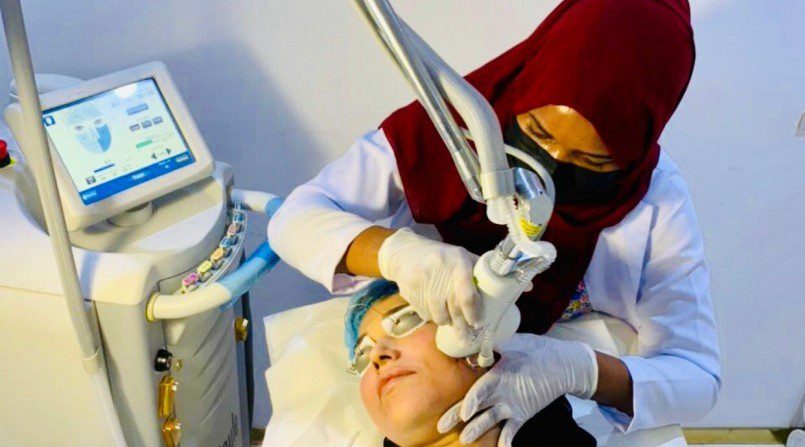Lactose Intolerance Test: How It Works, Types, and When You Should Take One

Did you know that many people experience bloating, stomach cramps, or digestive discomfort after consuming milk or dairy products? This is observed commonly in the late decades. If you suspect that your body is struggling to digest lactose, a lactose intolerance test can help you find the most reliable answer and diagnose your sensitivities. At SKIN111 in Dubai, we provide the latest advanced testing options, including the dairy intolerance test and milk intolerance test, to accurately identify the cause of your symptoms and guide you towards the right dietary and lifestyle solutions.
What is Lactose Intolerance?
Lactose intolerance can occur due to the body not being able to fully digest lactose. Lactose is a natural sugar found in milk and in dairy products. Usually when the small intestine is failing to produce an adequate amount of the lactase, lactose remains undigested. It leads to lactose passing into the colon and causing vivid symptoms like gas, bloating, abdominal cramps, and diarrhea. Taking a lactose intolerance test can be the most reliable way to identify if lactose is the true culprit of the discomfort you experience and if you are sensitive to lactose. For those who suspect being sensitive to milk proteins, the ideal way to diagnose is via a dairy intolerance test. A dairy intolerance test, or milk intolerance test, can provide additional clarity that you are seeking, allowing you to be sure if your discomfort is linked to lactose malabsorption or being triggered by a broader dairy intolerance approach.
Lactose Intolerance vs. Dairy Intolerance
Many people tend to confuse lactose intolerance with dairy intolerance, but they are two different conditions even though the symptoms may be similar. Lactose intolerance ensues when the body does not produce enough lactase to digest lactose; hence, it is a deficiency of the lactase enzyme.
Coherently, "dairy intolerance" is a wider term that may speak about the reactions triggered, not only to lactose but also to milk proteins such as casein or whey. A dairy intolerance test helps determine if your body is reacting to the proteins in dairy, while a milk intolerance test focuses specifically on sensitivity to cow’s milk. A lactose intolerance test only measures your ability to digest lactose sugar.
Understanding the difference between a lactose intolerance test, a dairy intolerance test, and a milk intolerance test is extremely important for accurate diagnosis and making informed decisions about your consumption. At SKIN111, we provide comprehensive testing to identify whether your symptoms are caused by lactose malabsorption, milk protein sensitivity, or a general dairy intolerance, so you can make the needful lifestyle amendments/ adjustments.
Dairy intolerance test:
A dairy intolerance test can be the tool to assess the body’s response to proteins in milk and dairy products, mainly casein and whey.
Milk intolerance test
A milk intolerance test is particularly designed to measure and diagnose how your body responds specifically to cow’s milk. This test can identify if the symptoms are linked to compounds in milk.
Lactose intolerance test
A lactose intolerance test pivots purely on the body’s ability to break down lactose. It measures how well the digestive system digests milk sugar and whether there is a deficiency of the lactase enzyme leading to symptoms.
How Does a Lactose Intolerance Test Work?
A lactose intolerance test distinguishes its sensitivities by analyzing how the body responds after consuming lactose. There are few methodologies, and the blood sugar level test for lactose intolerance and the hydrogen breath test are among the most popular ones. Stool acidity tests (often for pediatric patients) can also be assessed after lactose ingestion. These responses reveal whether the body is producing enough lactase enzyme to properly digest lactose or is declining.
Types of Lactose Intolerance Tests
At SKIN111, we offer several scientifically validated testing options to detect lactose intolerance and dairy sensitivity.
- Hydrogen breath test – measures hydrogen gas in your breath after consuming a lactose solution
- Blood glucose test – checks for changes in blood sugar after lactose intake
- Stool acidity test – often used for children and infants to assess lactose malabsorption
- Dairy intolerance test – advanced analysis of immune response and protein sensitivity
- Milk intolerance test – focused testing for cow’s milk sensitivity and intolerance
Preparation before Lactose Intolerance Test
At SKIN111 we are here to support you every step of the way. Before undergoing a lactose intolerance test or dairy intolerance test, it is important to be educated on refraining from certain foods, supplements, or medications that could affect the dependability of the results. Fasting may be advised occasionally. Our SKIN111 medical team shall always provide full instructions for pre- and post-testing, ensuring the reliability of the findings for accurate diagnostics.
When Should You Take a Lactose Intolerance Test?
Any instance you experience discomfort or symptoms after consuming lactose is an ideal time. You can monitor yourself in terms of responding towards certain types of food like dairy/milk/or lactose. Below symptoms may occur in your observations.
- Bloating after milk or dairy products
- Abdominal cramps or pain
- Excessive gas
- Diarrhea or loose stools
- Nausea after consuming dairy
- Ongoing digestive discomfort that worsens with milk intake
In cases where, despite avoiding lactose, you still experience persisting symptoms, it may be worth taking the tests, as this can indicate protein-related intolerance. Thus, you can rule out lactose as a not-guilty suspect.
Lactose Intolerance Test: Understanding Your Results
The results of a lactose intolerance test can solely depend on the method used. In adults, the most common way of testing is the hydrogen breath test. If hydrogen levels in your breath have significantly increased after drinking a lactose solution, it means that the body is not digesting lactose properly and undigested lactose is fermenting in the gut.
Another option is the blood glucose test, where a failure of blood sugar levels to rise after consuming lactose suggests that lactose is not being broken down into absorbable sugars and is being retained.
For infants and young children, the stool acidity test is often used. If the stool sample shows increased acidity or the presence of certain fatty acids, it denotes that the undigested lactose has reached the colon and caused further fermentation.
At SKIN111, our specialists are well trained in explaining and interpreting these results, helping you understand your symptoms better and identify the root causes of the symptoms while guiding you towards the right diet, enzyme therapy, IV therapy aid to support gut metabolism, or further investigations.
Conclusion
If you experience bloating, abdominal cramps, gas, or digestive discomfort after consuming milk or dairy products, taking a lactose intolerance test, dairy intolerance test, or milk intolerance test at SKIN111 in Dubai can provide the clarity you are seeking. These advanced tests are designed in the scope of accurately determining whether your symptoms are caused by lactose malabsorption, milk protein sensitivity, or a broader dairy intolerance. With precise testing and expert medical guidance from SKIN111 doctors and wellness experts, you can understand the roots of your symptoms, choose the right diet, such as lactose-free alternatives, use enzyme supplements if required, and make informed decisions for better digestive health, improved energy, and long-term well-being.
Most Popular:
-

Sciton HALO vs Sciton BBL
Read More »September 20, 2022 -

What is profhilo, and how is it different from fillers?
Read More »September 20, 2022 -

Body contour solutions from SKIN111
Read More »September 20, 2022 -

Does IV GLUTATHIONE therapy work
Read More »September 20, 2022 -

How can an IV drip help you boost your energy
Read More »September 20, 2022